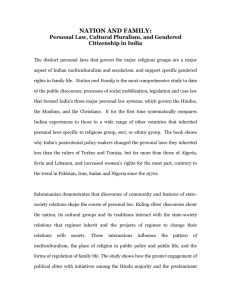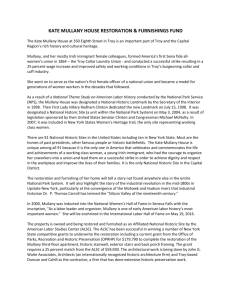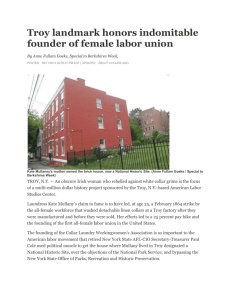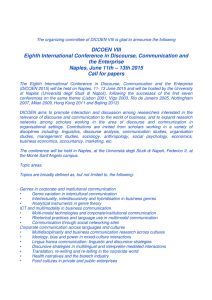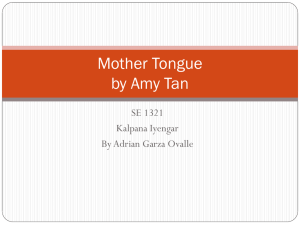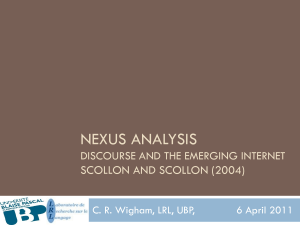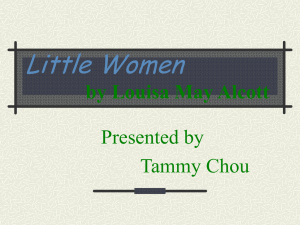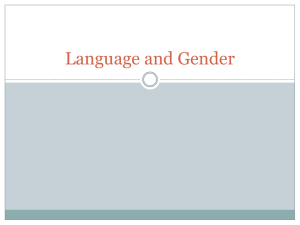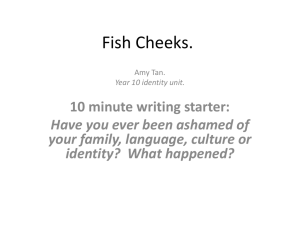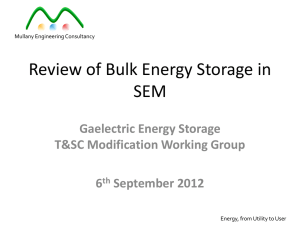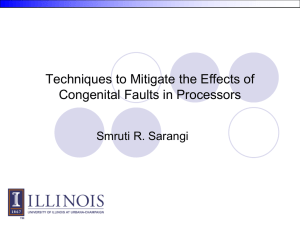Louise Mullany`s presentation
advertisement
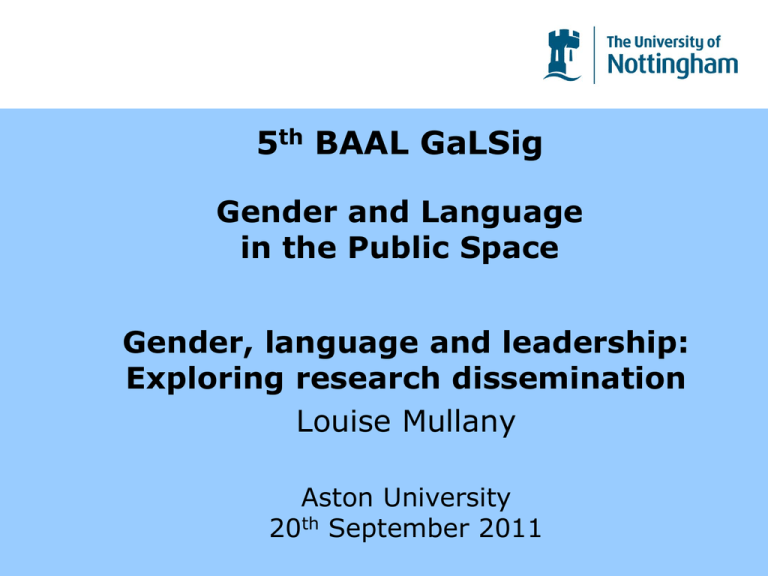
5th BAAL GaLSig Gender and Language in the Public Space Gender, language and leadership: Exploring research dissemination Louise Mullany Aston University 20th September 2011 Event themes & questions • Public space: Businesses and Organisations • Academic-practitioner relationships • ‘Impact’, ‘end-user’/’community engagement’ Background • Business School-English Language and Linguistics collaborations • MSc Communication and Entrepreneurship 2009-present • Gender and language components • Student-based consultancy work in the local community Current collaboration Community-based consultancies ‘Leadership Communication: Presence and Impact’: HR managers, training directors, practitioners etc. Gender and language components - Organisational Communication - Applied Linguistics - Drama/Performance Aims and objectives Applied Linguistic ‘toolkits’ Reflection and consciousness raising ‘Self-awareness and communication dynamics’ - Consciousness-raising - Critical language awareness - Workplace cultures Aims and objectives Applied linguist as problem solver (in a responsive, consultancy mode) Applied linguist as educator (in a proactive, futurist mode) Applied linguist as joint collaborator and coresearcher (in a consultative, reflexive mode) Sarangi 2006: 201) ‘Effective linguistics’ Sarangi (2006: 206) Aims and objectives At some point, our research has to be able to travel out of the academy in order to draw attention to and challenge unquestioned practices that reify certain behaviours as being morally or aesthetically better than others. We should never cease to engage actively with and challenge assumptions about gender norms and loudly draw attention to the way power, privilege and social authority interact with and are naturalised as properties of independent social categories. Holmes and Meyerhoff (2003: 14) Theory, methodology and practice (Mills and Mullany 2011) Methods of delivery 3 stage process: -pre-course preparation - 2 day course - Follow-up electronically & one-to-one Portfolio pre-assembly & 360 degree feedback Active learning sets Consent for research of these resources Adapting academic research Advantages/uniqueness: •Real world, non-scripted data from empirical research •Theory as practice • Applied linguistic toolkits Problems and Challenges •Managing expectations •Register and style •Diagrammatic representations etc. •Transcription presentations •Decontextualisation of materials •Political conflicts (Mullany 2008) Adapting academic research Theory as practice: Communities of practice Gender and language ideologies Gender stereotyping Gendered discourses Gendered workplace cultures The double bind: evaluations and judgements Not just gender: Social class, race, ethnicity, culture, regionality etc. Adapting academic research Applied linguistic toolkits: Turn-taking Conversational floors Speech acts Humour Small talk Politeness/relational work Conflict management and conflict talk Illustration of materials • • • • Awareness raising Own questions and issues Tailored to particular organisations Workplace cultures and communities of practice (Holmes 2006; Schnurr 2009) Discourse of gender difference, including gender and language ideologies (Sunderland 2004, Cameron 2007, 2009) Communities of practice a) Mutual engagement b) A joint negotiated enterprise c) A shared repertoire of negotiable resources Wenger (1998); Wenger, McDermott and Snyder (2002) Feminine Masculine indirect direct conciliatory confrontational facilitative competitive collaborative autonomous minor contribution in public dominates (public) talking time supportive feedback aggressive interruptions person/process oriented task/outcome-oriented affectively oriented referentially oriented Widely cited features of “feminine” and “masculine” interactional style (Holmes and Stubbe 2003: 574) Meeting data Amy is explaining departmental policy to Kirsty and Eddie Amy: we’re going to be carrying it for more than fifteen weeks= Karen: =yeah it’s ten weeks for stock and it will be calculated on how many sales within five weeks Amy: No it’s longer than that Karen Karen: Oh (.) right Amy: It’s longer Mullany (2007: 108) Interview data Karen: Amy’s subordinate: Amy is a very strong character very straightforward erm says what she means is very direct and it can be quite an overpowering experience talking to her. Mullany (2007: 171) Kelly: Amy’s status equal: Females are more caring generally (.) naturally more nurturing they’ve definitely got certain qualities that are different to men but some females can be real tyrants Mullany (2007: 172) Identity construction: Sex-role stereotypes • The mother role • The seductress • The pet • The iron maiden (Kanter 1977) Revisited in Baxter (2010) and Mullany (2010) Two female account managers here are not slow to use the combination of will and gender to good effect when they can see an opportunity to do so and that’s usually in the direction of a male person get what they want I’ve no doubt about it… that’s causing erm resentment from other males you know there are other account managers who were who were certainly were at the same level as them who feel they’re dropping behind because of the ability of the two females to exert their will gender mix to good effect. Mullany (2010: 188) Identifying workplace discourses • Presentation of research examples + participants identify the gendered discourses in their own workplace cultures • Dominant discourse of gender difference (Sunderland 2004) Gendered discourses and leadership – Discourse of female emotionality/irrationality – Discourse of motherhood and family – Dominant discourses of femininity: Image and sexuality – Resistant discourses (Mullany 2007:169-204) Gendered discourses and leadership Discourse of masculinisation (Baxter 2003) Gendered corporations (Baxter 2010): Male-dominated Gender divided Gender multiple Next steps • Piloting of materials • Working with individual organisations • Development of resources and interdisciplinary collaboration • Standalone leadership communication and gender course
